étudiante del monde | 20 houston | español | français | 廣東話 | 한국어 | main is @morganspeach | if im wrong in a post PLEASE correct me ty
Don't wanna be here? Send us removal request.
Text
New Year's Resolutions in Japanese
It's almost that time of year, to make resolutions that you may or may not keep! Here's how to make some of those resolutions in Japanese!
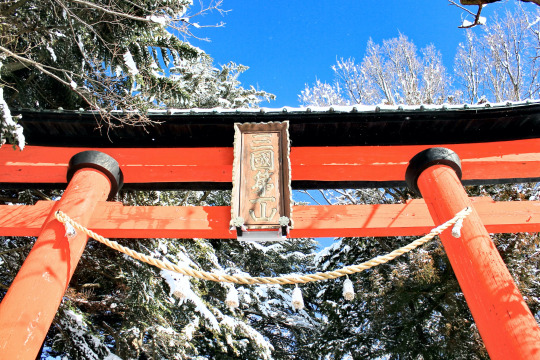
Vocabulary to Use for New Year's Resolutions
新年の抱負 しんねんのほうふ New Year's resolution
抱負 ほうふ aspiration; ambition; plan; hopes; wishes
新年の誓 しんねんのちかい New Year's resolution (less common)
誓 ちかい oath; vow
目標 もくひょう goal
習慣 しゅうかん habit
癖 くせ (negative) habit
Grammar Forms to Use for New Year's Resolutions
~(verb)たい want to do ~
毎日散歩したい まいにちさんぽしたい I want to walk every day
~(verb)こと verb nominalizer (allows verbs to act as nouns)
毎日ジムに行くこと まいにちジムにいくこと Go to the gym every day
~ことにする decide on/intend to do ~
毎晩10時の前に寝ることにする まいばん10じのまえにねることにする I intend to go to bed before 10 every night
10 Common New Year's Resolutions in Japan
健康に気を付けること けんこうにきをつけること Take care of one's health
本をたくさん読むこと ほんをたくさんよむこと Read a lot of books
家族と多くの時間を過ごすこと かぞくとおおくのじかんをすごすこと Spend more time with family
やせる Lose weight
お金を貯める おかねをためる Save money
禁煙する きんえんする Quit smoking
習い事を始める ならいごとをはじめる Learn something new
お酒の量を減らす おさけのりょうをへらす Drink less alcohol
運動の習慣をつける うんどうのしゅうかんをつける Exercise regularly
試験に合格することにする しけんにごうかくすることにする Pass an exam
How to Stick to Your New Year's Resolutions
自分、あるいは他の人に責任を持たされる じぶん、あるいはほかのひとにせきにんをもたされる to be held accountable by yourself or by others
抱負の数を限る ほうふのかずをかぎる limit the number of resolutions
抱負を細かく決める ほうふをこまかくきめる decide resolutions in detail
What are your New Year's resolutions?
162 notes
·
View notes
Photo




Lai Yiu-Fai… let’s start over… Ho Po-Wing always says, “Let’s start over,” and it gets to me every time. We’ve been together for a while and we break up often… but whenever he says, “Let’s start over, ” I find myself back with him.
春光乍洩 Happy Together (1997) Wong Kar Wai 王家衞
2K notes
·
View notes
Text
I met up with my old Taiwanese language exchange buddy (who moved to China but is back on a business trip) after not seeing him for five and a half months. We got 木瓜牛奶 mùguā niúnǎi (papaya milk) and 地瓜球 dìguāqiú (sweet potato balls) and hung out in the park and caught up. I got some new vocab out of it:
褻瀆 xièdú / blasphemy (against the gods…I was talking about putting cheese on 地瓜球)
調皮 tiáopí / naughty, mischevious
一國兩制 yīguó liǎngzhì / one system two governments (ie: China and Hong Kong)
急救人員 jíjiù rényuán / first aid personnel, EMT
符合 fùhé / to get back together (as of a couple who broke up)
中年危機 zhōngnián wēijī / midlife crisis
帳號 zhànghào / account number
塗鴉 túyā / graffiti
復活 fùhuó / to come back to life, resurrect, revive
地頭蛇 dìtóushé / snake in its home territory, local gangster
乾爹 gāndiē / sugar daddy (Pleco says “godfather” but at least in Taiwan it’s definitely the former)
人妖 rényāo / an inappropriate word for a transgender person, 跨性別人 kuà xìngbié rén is the (polite) norm in Taiwan
176 notes
·
View notes
Text
Vocabulary: What Does 원래 Mean?
안녕하세요 여러분! This week’s lesson is a little bit about the word 원래, which is a word I heard all the time in Korea. I hope it’s helpful! You can find this post on my Instagram too! 화이팅!


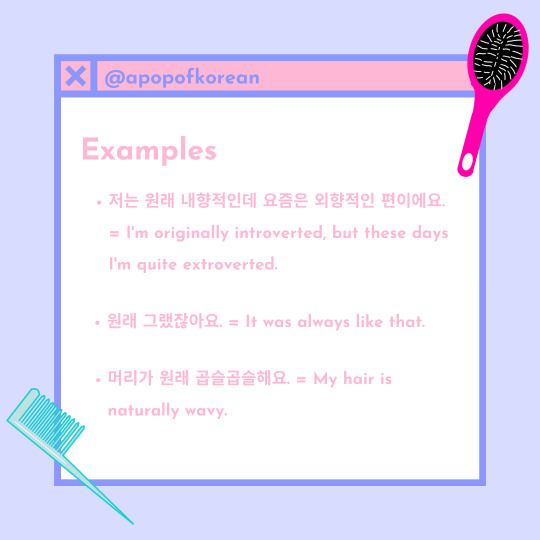


My masterlist
Join my Discord chat here to practice Korean with others!
Follow me on Instagram here for more Korean content!
Check out my Ko-Fi to support this blog and my studies! Thank you for your generosity!
138 notes
·
View notes
Text
Yoga Vocabulary (French)
prof de yoga = yoga teacher
le tapis = yoga mat
accélérez = go faster
accroupissez-vous = crouch down
debout = standing
sangle de yoga = strap
accrochez les doigts = interlace your fingers
la posture du héroes = hero pose
inspirez = inhale
expirez = exhale
132 notes
·
View notes
Text
my boyfriend is learning spanish and... i had to share

4 notes
·
View notes
Text
my korean practice today:
some grammar, school stuff and handwriting/sentence practice
tw; dirty joke with limited korean in my writing practice (im sorry, i saw the chance and took it 유유)
had a black bean burger, some eggs and élote tostado
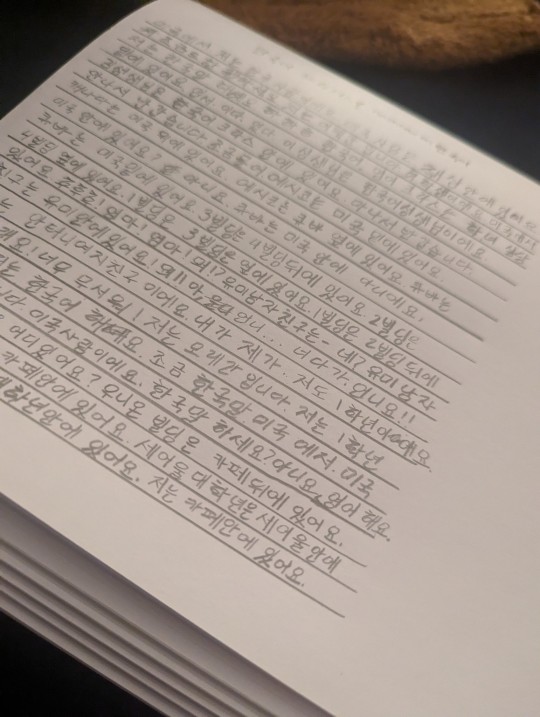
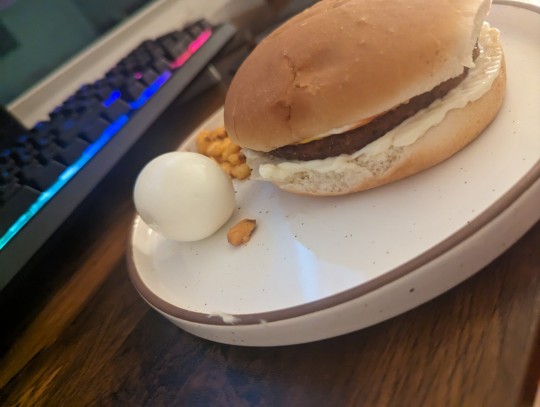
2023. 07. 23
#langblr#korean langblr#studying#writing practice#hangul#food#feel free to correct my sentences and spelling! ill probably go through and fix some spelling later lol
5 notes
·
View notes
Text
Try speaking in front of a mirror
I HIGHLY RECOMMEND THE FOLLOWING EXERCISE FOR THOSE LEARNING ANOTHER LANGUAGE:
speak to yourself in front of a mirror,and attempt to only use your target language
some guidelines i would use for beginners esp: try to use vocab you already might know (example: i speak _ language and i want to eat _ food), and try to keep speaking as long as possible. reiterate what you just said with a different sentence format, literally just speak as varied and as long as you are able to
this does a few things:
- shows what words and sentence structures you have a handle on
-what words you should learn next to keep speaking (words like for, this, now, tomorrow, yesterday) that dont always show up in vocab lists
-what you struggle with
-practices your speaking brain muscles, since you are only looking at yourself and not getting any assistance
others have probably already mentioned this, i feel like i heard about this from somewhere before but I can't remember but i just tried this and loved it
below i accidentally clicked the question button and couldnt delete it so now i ask you this question:
#cantonese langblr#langblr#studying#french langblr#it was daunting until it wasnt#boosted my confidence in my french BIGTIME#NOTE ive been doing some sentence writing practice the past few days which definitely helped#korean langblr#language tips#speaking tips
43 notes
·
View notes
Text
Target Language Reading Challenge
I'm starting a new reading challenge for myself and I'd like to invite the rest of the tumblr langblr and studyblr community (and I may repost on my studygram) to participate. Honestly, while I made this with the intentions of the langblr community using it to strengthen reading skills in our target languages, I think anyone who loves reading or wants some encouragement reading may enjoy participating.
Make sure to use the tag #onigirireadingchallenge so that I can see and reblog.
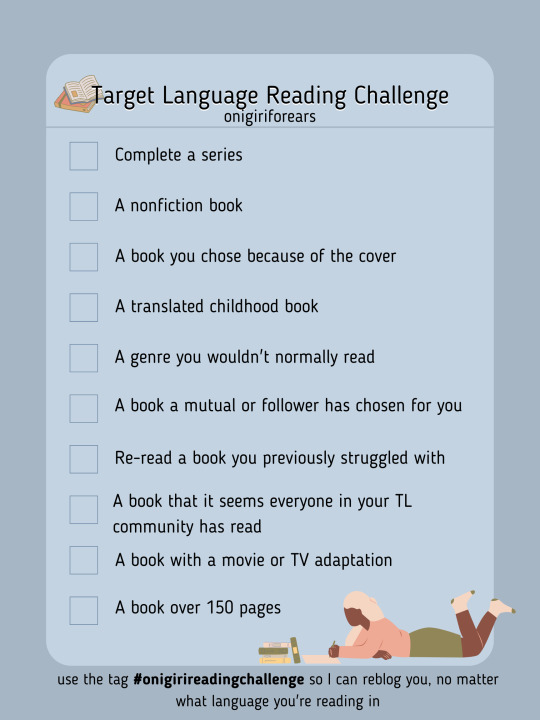
If you want a higher quality of the image, it's available here.
608 notes
·
View notes
Text
Masterlist Langblr challenges
Following from my previous posts, if you do feel like working on your languages, but don't know where to start; here are some langblr challenge you might like!
Language Blog Challenge: 20 weeks of challenges | by @lily-learns-finnish
Langblr Reactivation challenge | by @prepolyglot
14 Day langblr challenge | by @lass-uns-studieren
Langblr News challenge | by @tealingual
90-day vocab challenge | by @jibunstudies
100 Happy Days Langblr Challenge | by @nordic-language-love
Mini speaking challenge | by @nordic-language-love
16 words challenge | by @neblina-a-blin
30 day langblr challenge | @moltre-s
Brick-by-brick language learning challenge | by @linguistness
Langblr word of the day challenge | by @nordic-language-love
Target Language Reading challenge | by @onigiriforears
P.S. Please let me know if you know some more fun langblr challenges!
572 notes
·
View notes
Text
So I've been playing around with Cāngjié…
And I thought a post like this (similar to a post on Zhùyīn done by linghxr) may be of interest to some.
What (and who) is Cāngjié?
For those who may not know, Cāngjié is another way to input 漢字/汉字 (Hànzì — Chinese characters). It is way less popular than Pinyin (or even Zhuyin) but it still has its fans, and has a few advantages over the other two.
Cāngjié is also the name of the mythical figure in Chinese legend who is said to have been the inventor of 漢字/汉字, for which Cāngjié (the input system) was named after.
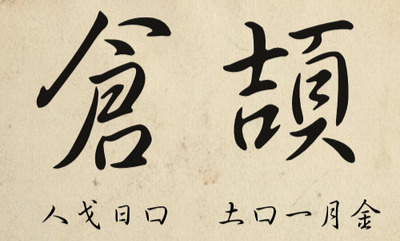
Would I recommend it?
Yes, if you think you have already acquired a good (enough) understanding of 漢字/汉字, and/or just like a new challenge.
(TL;DR at the end)
Why am I learning Cāngjié (and why you may like to, too)?
1. Mostly for fun.
Have long been intrigued by both Cāngjié and Zhùyīn, and since I finally mustered up the courage to tackle Zhùyīn not too long ago, I thought I'd finally give Cāngjié a try.
While learning Cāngjié does require more effort than learning Pinyin or Zhuyin, it can also be really fun! Inputting 漢字/汉字 with the Cāngjié method is almost like doing a jigsaw puzzle.
The euphoria derived from figuring out and piecing together the radicals that make up a word is something that learning Jyutping (Cantonese equivalent of Pinyin), Pinyin or Zhuyin can't quite match.
And while I know I'll never be as adept with Cāngjié — my knowledge of 漢字/汉字 is nowhere near good enough to ever use Cāngjié efficiently — as I do Jyutping or Pinyin (or to some extent, Zhuyin), it'll still be fun to use Cāngjié every once in a while!
2. Helps with thinking and typing in Chinese.
The upshot of relying too much on using Jyutping/Pinyin/Zhuyin is, I'd tend to think in Roman letters or ㄅㄆㄇㄈ before I'd even think about the actual 漢字/汉字.
But with Cāngjié, because it's based on knowing radicals and joining them together to form actual characters, it'll encourage thinking of 漢字/汉字 first, so I think that would help some with 漢字/汉字 memory retention.
Now you may be thinking, why not just you know, practise actually writing then? That is the tried and proven method to better remember 漢字/汉字 after all?
Yes, of course I can do that — and am doing so occasionally — but we live in a digital age now, and the probability and opportunity to type things out is much higher than actually writing stuff by hand.
The idea here is, more looking to think of and envision characters fully in my head, and trying to lessen over-reliance on Jyutping/Pinyin/Zhuyin.
And this is where I find Cāngjié can be useful, which leads to my next point…
3. Haunted by “What if” scenario.
What if there comes a day (however improbable) where I'm presented with only a Cāngjié keyboard to use for typing Chinese? It has happened with Zhùyīn for me!
That means, no Pinyin or Zhuyin keyboards, no Handwriting tools/touchscreens to write with fingers/mouse, no speech-to-text, and no option to copy-and-paste characters from somewhere else either! What then?
4. Able to type without knowing pronunciation, and with more accuracy.
Cāngjié is shape-based. Unlike Jyutping/Pinyin/Zhuyin, where you have to know what a character sounds like before you can type it out, with Cāngjié, you can type out (again assuming no Handwriting or other tools available) characters without needing to know how to pronounce them at all.
With shape-based typing, you'd also get more accurate hits in the first few 漢字/汉字 that show up, versus sound-based methods like Pinyin where for e.g., typing out “wan” will get you a whole list under the same sound and you may have to scroll through a whole lot to get the exact “wan” you need.
You can also type both Traditional and Simplified characters without having to toggle something or switch keyboards.
So how does one begin learning Cāngjié?
Install a Cāngjié keyboard.
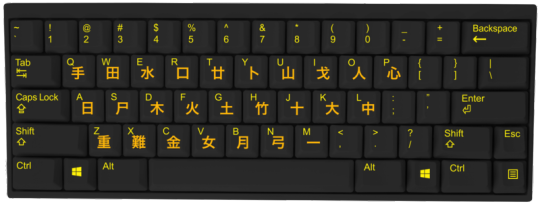
Duh…but of course! Heh! Gboard offers one, banded under Cantonese language input (Android user here, don't know about iPhones, sorry).
There are two versions of Cāngjié that are prevalent currently. Cāngjié 3 and Cāngjié 5. Cāngjié 5 is supposed to be an improvement over version 3 but I don't find there's much; having a slightly altered version just adds to the confusion and unnecessarily complicates matters, in fact!
If you have a choice, I'd recommend selecting Cāngjié 3 as that is more supported. Some operating systems may not be too compatible with Cāngjié 5 still, for some strange reason.


You may also come across something called “Quick” (速成) aka, “Simplified Cāngjié”.
This is simply a scaled down version of Cāngjié, it's still based on Cāngjié's formula. So you still need to know how Cāngjié works in order to use “Quick” efficiently.
You'd then need a chart like this. ↓
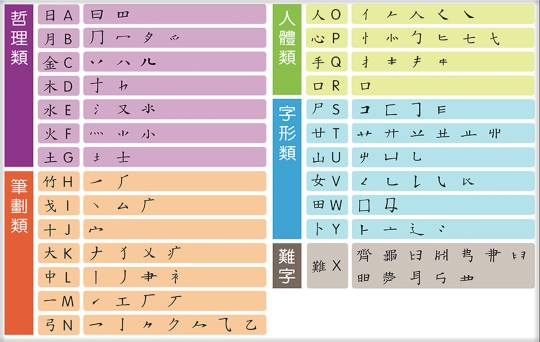
* the 重 (Z) key doesn't really come into use. I don't really know what it's for, but it seems to be used (paired with other keystrokes) mainly to type out various punctuation marks.
There are variants out there, some having a little more, or less, radicals shown than in the above example, but I'll say the chart here is one of the more comprehensive ones I've found so far (and sufficient enough) — other charts often fail to highlight the 難 (X) key and what it corresponds to.
You don't have to memorize the chart all at once. Just always have a chart like this on hand to refer to and with enough typing practise, you'll eventually remember which key corresponds with which radicals.
Remember the rules. ↓
“1 part” character (e.g. 寫) = first 3 & last (radical).
“2 parts” character (e.g. 唔) = first & last, first 2 & last.
“3 parts” character (e.g. 難) = first & last, first & last, last.
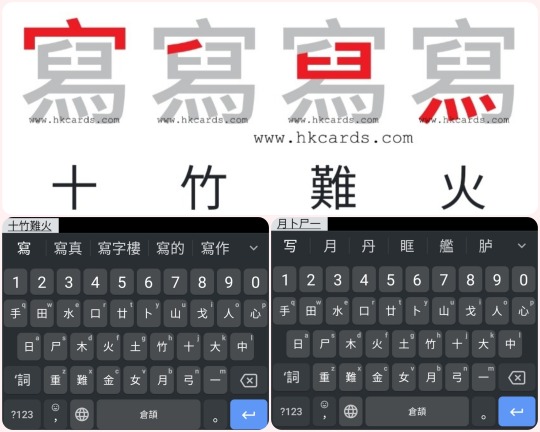
e.g. 寫 ↓
With radicals 宀,丿,臼 (first 3) and 灬 (last).
Corresponding keys: 十,竹,難 and 火。
寫 → 写 ↓
With radicals 冖,卜,㇆ (first 3),一 (last).
Corresponding keys:月,卜,尸 and 一。

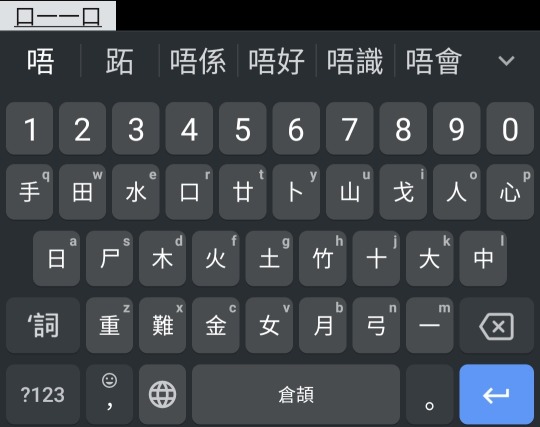
e.g. 唔 ↓
With radicals 口 (first & last),一,一 (first 2),口 (last).
Corresponding keys: 口,一,一 and 口。
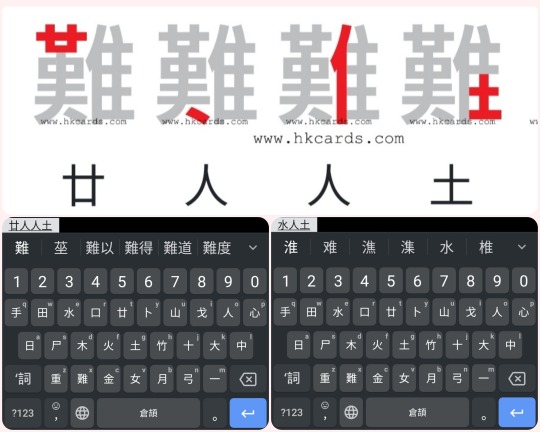
e.g. 難 ↓
With radicals 廿,人 (first & last),亻(first & last),土 (last).
Corresponding keys: 廿,人,人 and 土。
難 → 难 ↓
With radicals ヌ (first & last),亻(first & last),土 (last).
Corresponding keys: 水,人,and 土。
Occasionally, you may get a character that looks like a “2 parts” but is actually a “3 parts”. ↓
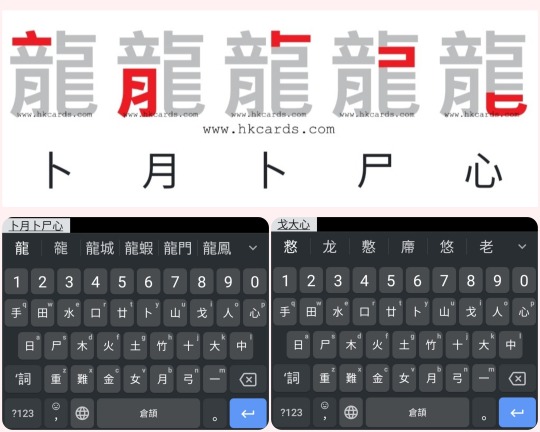
e.g. 龍 ↓
With radicals 亠,月 (first & last), 卜,コ (first & last),ヒ (last).
Corresponding keys: 卜,月,卜,尸,and 心。
龍 → 龙 ↓ (Simplified 龍 → 龙,a “1 part” character)
With radicals 丶,ナ,ヒ (first 3).
Corresponding keys: 戈,大,and 心。
Or looks like a “1 part” but really a “3 parts”. ↓
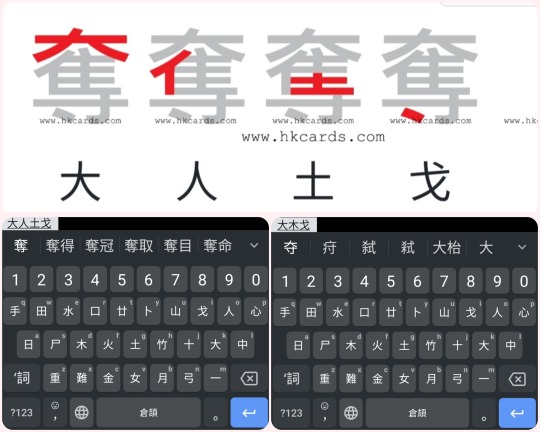
e.g. 奪 ↓
With radicals 大 (first & last),亻,土 (first & last),丶 (last).
Corresponding keys: 大,人,土,and 戈。
奪 → 夺 ↓(Simplified 奪 → 夺,a “1 part” character)
With radicals 大,寸 (first 3; the 丶 is the 3rd component).
Corresponding keys: 大,木,and 戈。
But these are exceptions, and don't occur that often.
And you can start practising!
You can try out this pretty good app called 『五色學倉頡』 (learning Cāngjié with 5 colours), for practise. It's on Playstore, just search for “Cangjie Dictionary” and it should show up.
You have to pay to unlock higher levels, unfortunately. ↓


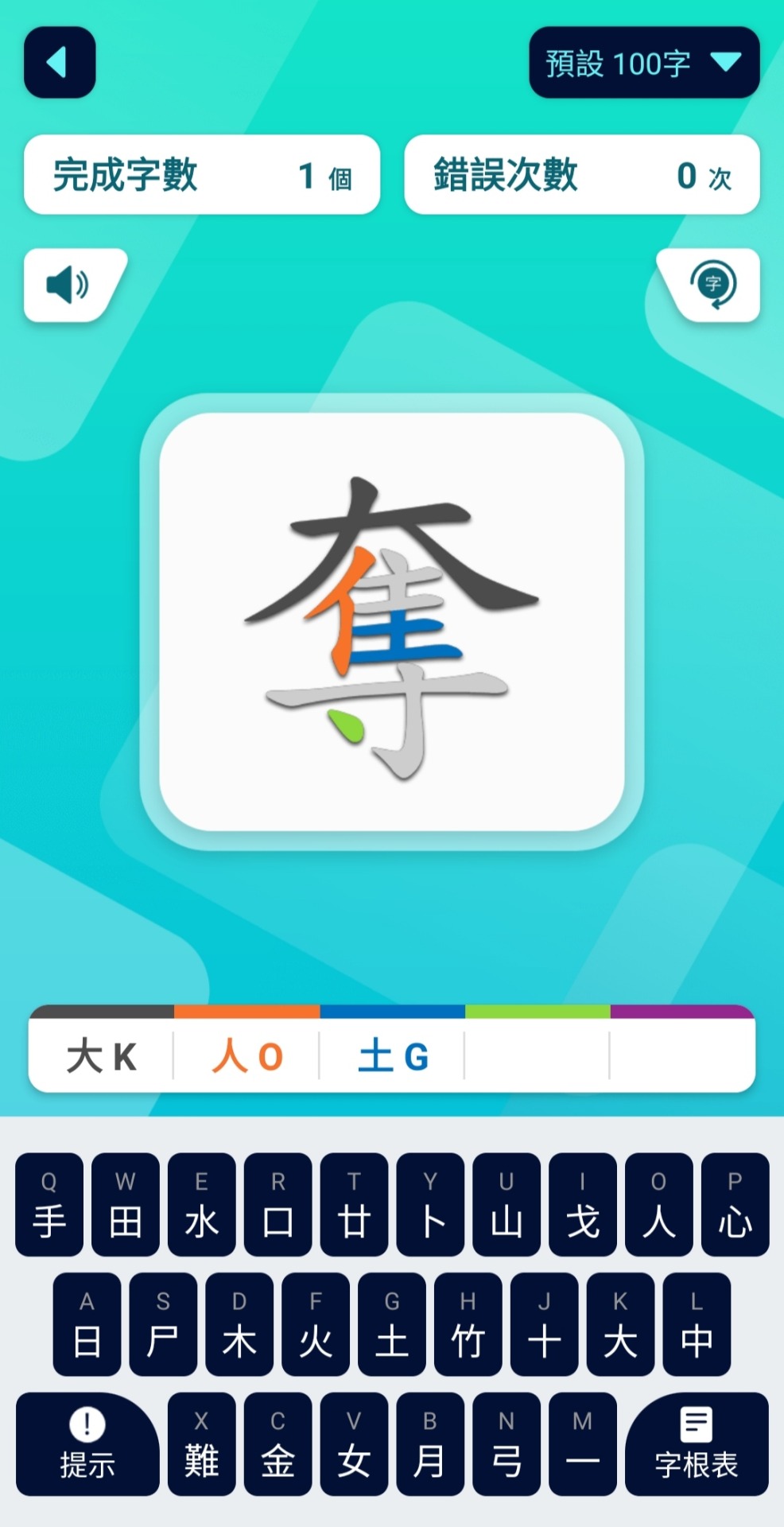
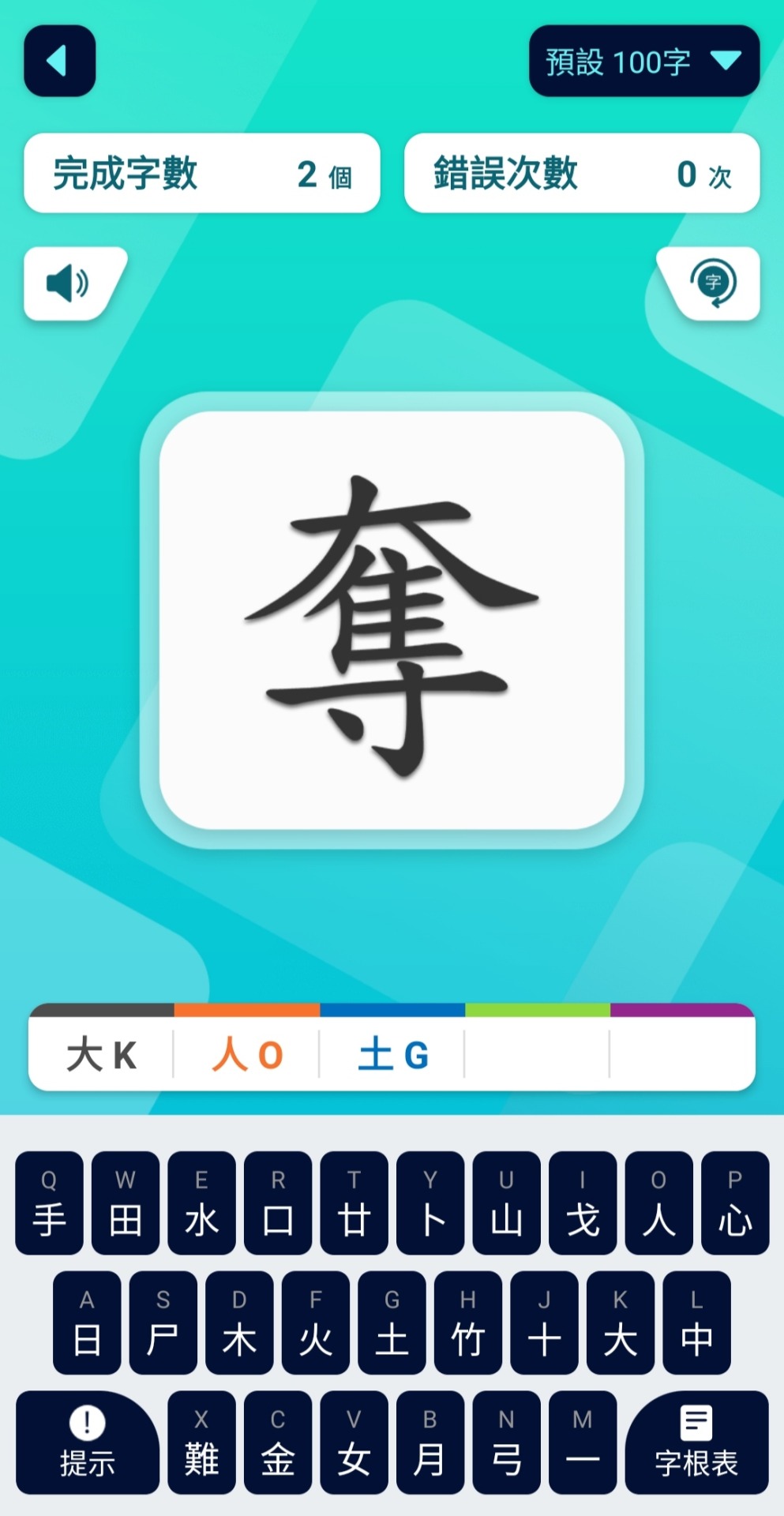
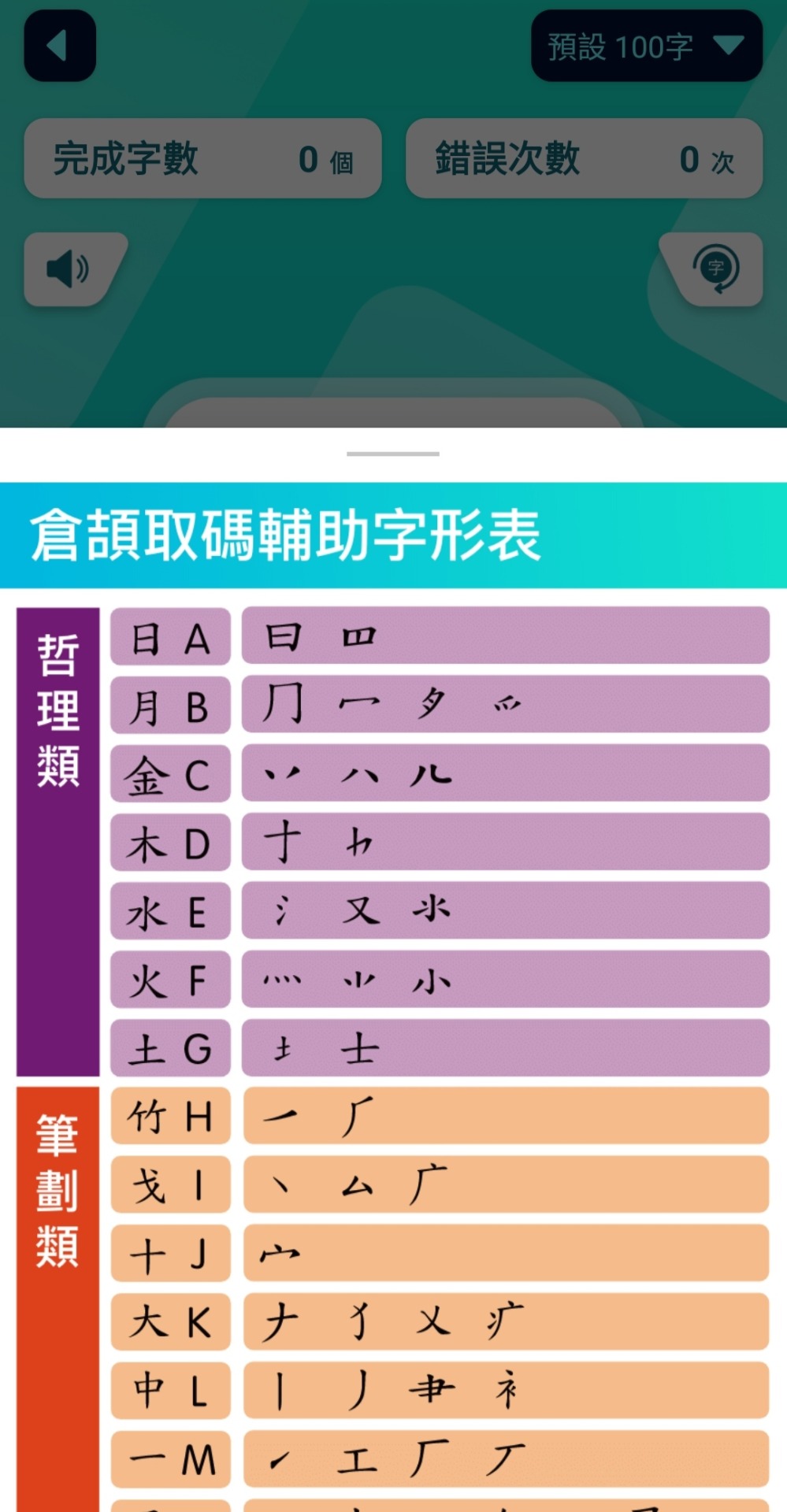

Anyway, each character comes with colour coded hints and you can opt to turn them off if you like more of a challenge. There are also hints (提示) and the chart (字根表) to refer to if you're really stuck. Also has a dictionary component (查字典) to check out the Cāngjié input for characters.
Another option would be a website called HKCards. ↓


You can use it to check the Cāngjié input for any 漢字/汉字, and there's section for practise (倉頡輸入法練習) as well. After inputting your answer with Cāngjié keys (手田水口廿卜), you can click on the “Answer” (答案) button to see how right or wrong your answers were. ↓

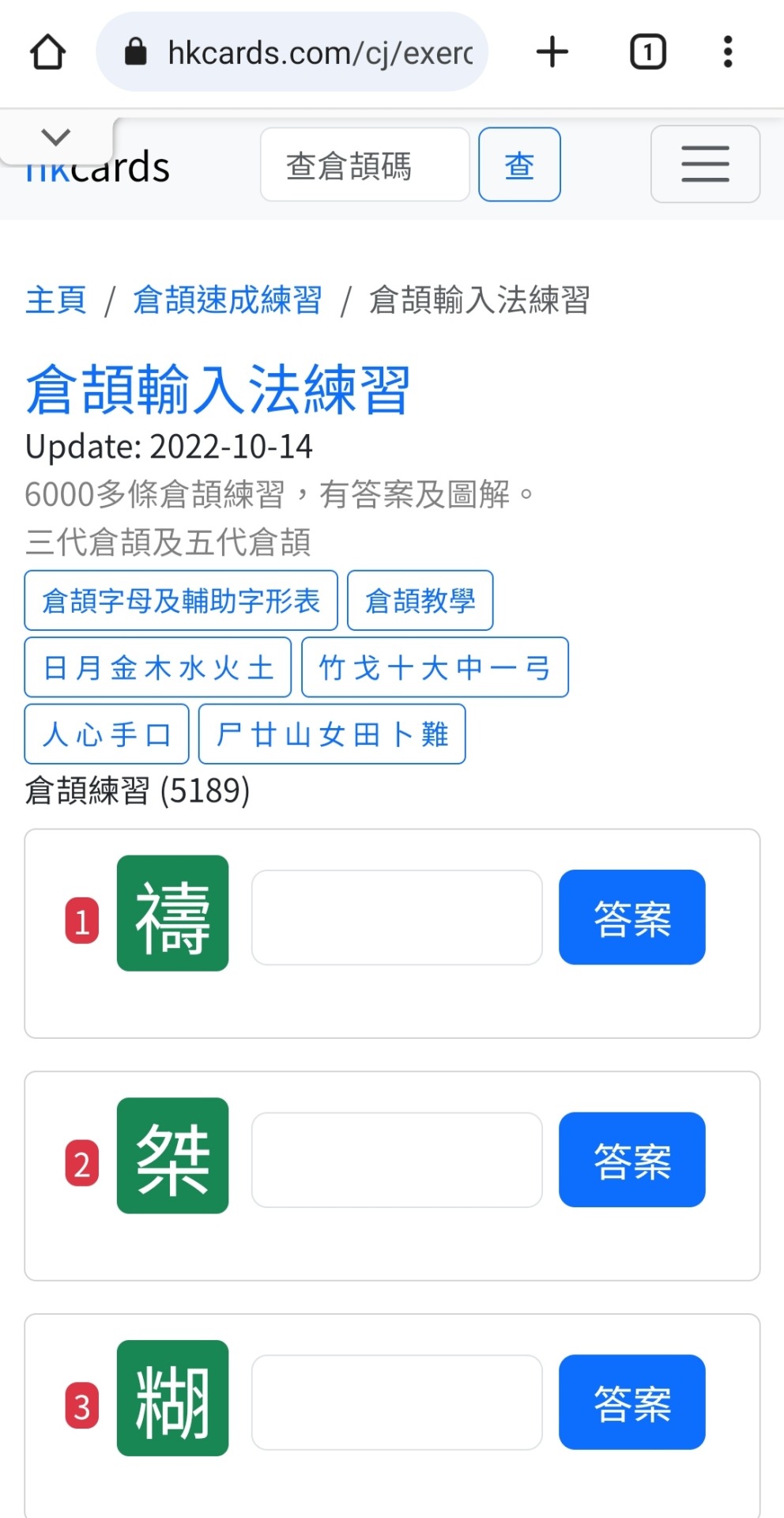


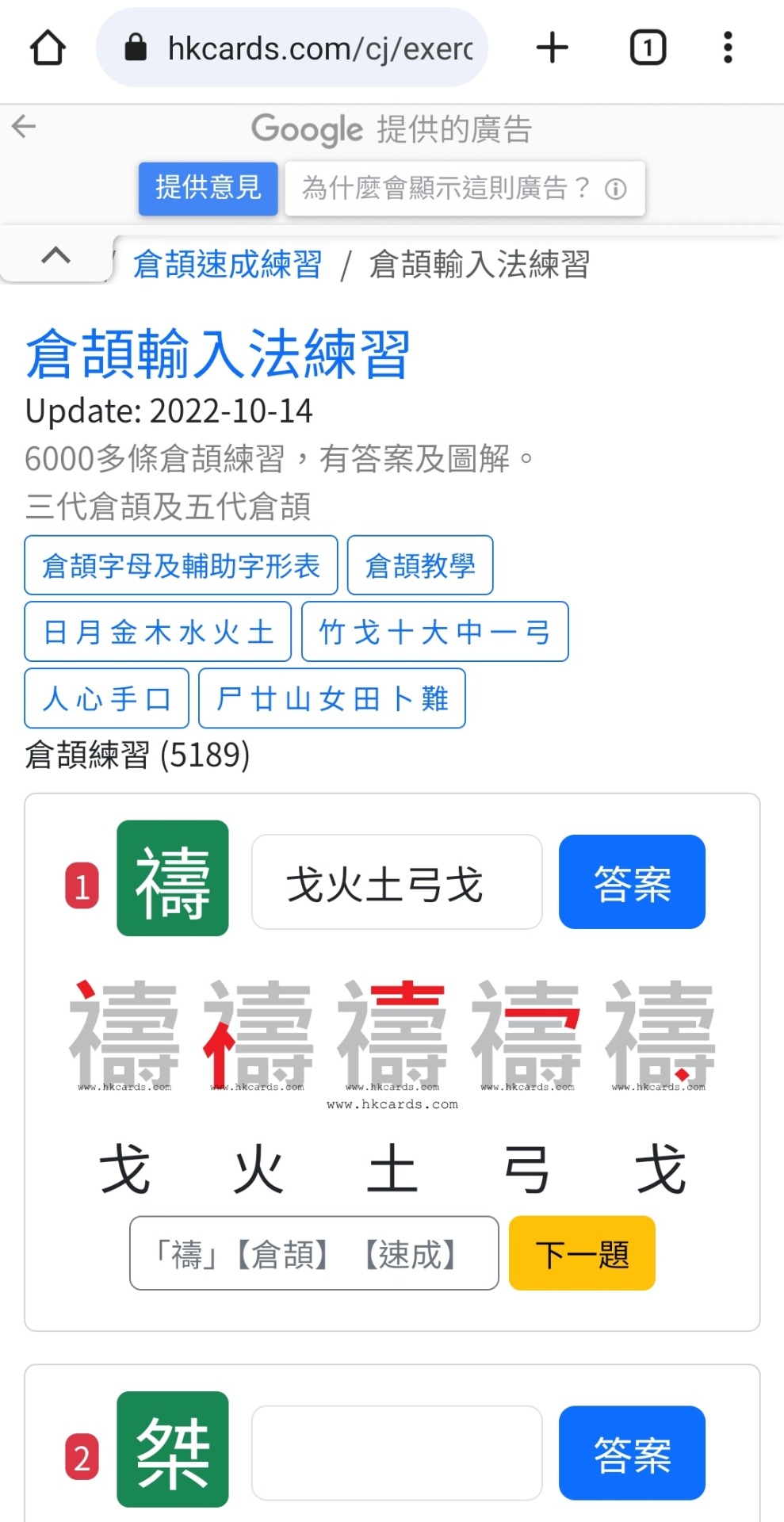
There are 8 characters each time, and you can just hit “Practise Again” (再做練習) to refresh for another 8 to practise with. I've yet to hit a limit.
Unfortunately, this website has lots of ads popping up. And it only supports searching in Traditional characters (Cāngjié was initially catered more for Traditional).
Or you can just try practising randomly with a Cāngjié keyboard and check for mistakes with a Cāngjié dictionary (『五色學倉頡』 app's dictionary comes in really useful here — it appears to support searching in Simplified too).
TL;DR
Cāngjié could be useful (and fun) to know if your 漢字/汉字 knowledge is already adequate, and/or you just like a new challenge.
And if watching videos is more your thing, here's a really helpful YouTube tutorial on how to use Cāngjié (has English subs)!
266 notes
·
View notes
Text
just added in all my new keyboards,got the urge after going on pinterest and seeing a physical keyboard sticker for Korean and now im like,,, so i should get three different keyboards huh? (one for kr,jp,ch ofc)
i tried to pick the ones commonly used in the countries i want to emulate (idk how to describe but there you go)
so english - qwerty
français - azerty,
한국어 - single vowel, bc it takes up too much space otherwise,easy money ngl but im used to the 2-vowel one so its a bit strange to use for ㅑㅕㅖand stuff like that
廣東 - traditional with cangjie setup, i saw online that they use it in HK so i chose it lol. okay this has a learning curve ugh, its okay though im still alive. cant find the damn 'language' radicals so im preparing myself a coffin
#could just copy n paste but why would i do that#ngl just using the voice to text thingie bc absolutely no way do ik how to use a chinese char keyboard#surprisingly the characters for 廣東 came out right!! go me#lol i have to fake a mandarin accent to do it tho bc there was no canto option#only 中文 for these hoes apparently#cantonese langblr#french langblr#korean langblr#keyboard input
16 notes
·
View notes
Text
🌿🌕✨
外国的月亮比较圆 - “the moon is rounder in other countries”
A funny phrase I learned today, the equivalent of “the grass is always greener on the other side”!
Do you feel that way sometimes too? 🌝
483 notes
·
View notes
Text
Cantonese Podcasts on Spotify

InspirLang: Learn Cantonese Daily - These are really short, bite-sized lessons with basic structure and vocabulary. Great for repeating often.

CantoneseClass101.com: Learn Cantonese - So these are longer. These are dialogues with culture tidbits. They go over a few lines, normal speed then slowly.

Chatty Cantonese - Perfect for grammar and slang, along with cultural and learning Cantonese itself (the hosts are a Cantonese native speaker and a English native who learned in HK). Also how to apply the language.

Whatsuuup ?! - I don't have a Chinese keyboard on my phone yet so I can't type the full name lol. But this is literally entirely in Cantonese with native speakers, so it's good for more intermediate or advanced learners. They cover a variety of topics as well!

Poetic Cantonese: Speak from Day 1. Be fluent in Year 7 - This is also run by a native speaker, who slowly goes through sentences. He's done a lot of different courses from beginner to advanced.
Okay! I hope these resources help you out!! Cantonese is such a pretty language and I really like listening to it (speaking it even more so)
9 notes
·
View notes
Text
lol yeah italian is on the back burner until 2024
i really only need survival italian for my aunts wedding lol, everyones going to italy then!! but its all the way in sept '24 so im not pressed for time
currently using duolingo, drops and pimsleur (soon-to-be) for french and italian
the goal is to study there, so i've gotta get good soonish, a year or so
the main issue is that they kinda push each other out when i study back to back, so im planning to learn more french first before focusing on italian. it's tickling my brain more anyway so it works out
this is 15ish days since i've started on duolingo, so we'll see how it plays out
2 notes
·
View notes
Text
My Korean study resources [2020 Q1]
People were asking me what I’m using right now to self-study seeing as I’ve stopped taking lessons. I have to admit - its really really difficult to keep motivated actually but switching up resources keeps things fresh so I can continue being happy like my kid Felix [KEEP READING]

Keep reading
26 notes
·
View notes
Text
Writing “Chinese” in Chinese
Here is a little bit of information that I thought would be great to share!
So whenever I’m writing my tags or trying to introduce myself, I think about how I would actually write the name of my target language. So for example, to say “I am learning Spanish” I would write “ Estoy aprendiendo español”. The translation is simple. But for Chinese, that’s not the case.
There are differences in Chinese as it’s written versus when it’s spoken. There’s also differences between Mandarin Chinese and Cantonese Chinese. It was interesting trying to make sense of which ones to use and when, so I looked it up! I used several resources, which will be linked at the end.
Below, I have the noted words, with both Mandarin and Cantonese pinyin and jyutping to showcase how it’s pronounced. There are also detailed explanations as well. Anyway, here it goes!
Keep reading
42 notes
·
View notes